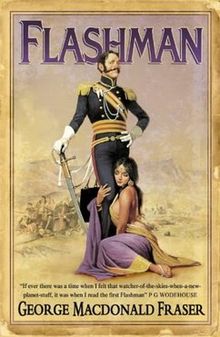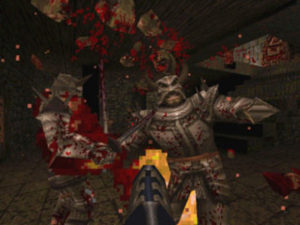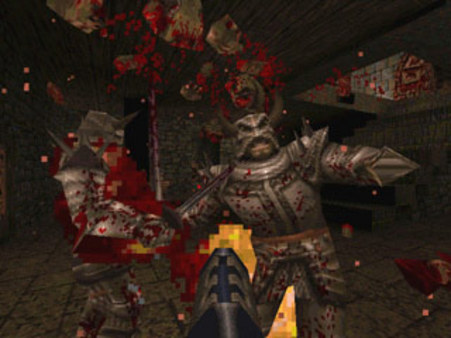 Kerry Packer was Australia’s richest man, and he didn’t care who knew it. It was dangerous to mention your own wealth in his company. Once, at a baccarat table in Vegas, a Texas oilman bragged that he was worth sixty million. Kerry didn’t miss a beat. “Toss you for it.”
Kerry Packer was Australia’s richest man, and he didn’t care who knew it. It was dangerous to mention your own wealth in his company. Once, at a baccarat table in Vegas, a Texas oilman bragged that he was worth sixty million. Kerry didn’t miss a beat. “Toss you for it.”
Metallica’s like that. It’s all or nothing. Once they decide on a direction, they take that direction to its full or logical conclusion. Sometimes that conclusion is “Ride the Lightning”. Sometimes it’s “Lulu.” And now we’re here, with an album that’s average, but strangely intense in its averageness, if that makes sense. Imagine pouring a mug of tapwater, that’s utterly uncompromising in its 50C-ness. The definitive mug of lukewarm water, that all mugs of lukewarm water aspire to be.
Hardwired tries to merge their 80s thrash metal sound with various hard rock influences, with somewhat good results. I was hoping for more, but it’s listenable and well put together. Greg Fiedelman’s earthy production job stops things from sounding too modern, but the album doesn’t have a sonic “center”. There’s not a single track you can point to as a summary of the album’s thesis. It jumps around in style a lot, and also in quality.
The performances shocked me. James’s voice sounds…good. No more “GIMME FUE GIMME FAI GIMME DABAJABAZA” enunciation. And he’s backing it up live, too. Lars’s drumming is basic but sounds pretty decent now that he’s mixed in a non-asinine fashion. The band probably pulls of its best rhythm tone to date, with the guitars like a scorching streak of red war paint against the dry skin of the bass and drums. Everything works, everything makes sense.
The weak performer on the album is obviously Kirk Hammett. His bad habits are now incredibly pronounced, turning songs like “Confusion” into your one stop shop for bad Jimi Hendrix imitations. Sloppily played pentatonic runs, drenched in masturbatory wah pedal noise, written with no thought, no technique, and no ability to “ride” the feel of the song. On 2008’s Death Magnetic, he didn’t stand out at all. Now, he’s actively making the band worse.
If you agree, take heart from my suspicion that he won’t be in Metallica much longer. Note that he has zero writing credits on the album, and my reading of Blabbermouth reveals a dog-ate-my-homework level excuse about losing the phone that had all his riff ideas (should have lost the phone that had his shitty guitar solos, instead). I don’t buy it. There’s kids on Youtube who can play every riff Metallica ever recorded, but Kirk Hammett needs a phone to remember his own material? His heart is obviously no longer in this band and I predict he will be the next member to leave.
But he keeps his noodling down to a few seconds per song, leaving us with Hetfield’s amazing left hand and surprisingly decent voice to carry the album, and they both do…to an extent. “Hardwired” doesn’t stand out to me as excellent material, but “Atlas, Rise!” and “Moth into Flame” are incredible, capturing everything that was good about the Black album and marrying with a greater sense of musical adventure. If the whole album had sounded like this, a renaissance would be underway.
“Now That We’re Dead” and “Confusion” sound like efforts at arena rock. I can tolerate them, if not love them. Much of the second album is skipworthy, with the big exception being “Spit Out the Bone”, which brings back the riffs and speed and evokes memories of “Damage Inc” and “Dyers Eve”.
The pace of the album is fairly staid: I could have used more speed and energy. And this is one of those single albums turned into a double disc for no reason at all: I suspect you can make a far superior version of Hardwired…to Self Destruct by deleting/rearranging some of the tracks. Nothing like having to perform emergency triage surgery on an album, but there’s enough good material here that it’s a worthwhile endeavor.
Being a Metallica fan is exhausting. Some think they should have retired in 1991. Some think they should have retired in 1988. Some think they should have retired in 1981. No matter where you stand, this might be the closest to a return to form we’ll ever get, and I know not to look a gift Horseman in the mouth. Metallica tossed for it, and I don’t know if they beat the house, but they’re still here doing what they do.
 Stockbrokers cheered as they watched Wolf of Wall Street. Thousands of girls tried to redeem Draco Malfoy through fanfiction. It’s actually pretty hard to create a bad guy that people actually dislike.
Stockbrokers cheered as they watched Wolf of Wall Street. Thousands of girls tried to redeem Draco Malfoy through fanfiction. It’s actually pretty hard to create a bad guy that people actually dislike.
Flashman take a bully from Thomas Hughes’ Tom Brown’s School Days and describes his later adventures in the British Raj (and beyond). He rides horses, plays cricket, embarrasses himself in battle, and has carnal knowledge of many famous historical women.
He’s incredibly cowardly, but his attempts to desert, abandon, and betray his own side are always misunderstood as acts of heroism, and he emerges from each book with a lapel weighed down by still more (spectacularly unearned) medals and decorations.
Fraser seems to be taking shots at Victorian-era vainglory. Or maybe he’s not even being cynical: Flashman legitimately inspires people, even though his heroics are a sham. If someone as fundamentally worthless as Flashman can achieve glory, what’s your excuse?
The books are hilarious and action-packed. What’s often ignored is how well researched they are. Fraser was himself a soldier, a journalist, and a historian, and the Flashman Papers are packed full of footnotes illuminating the time period, all written as if Flashman was a real historical figure. (“Flashman, like many other European writers, uses the word “Ghazi” as though it referred to a tribe, although he certainly knew better. In Arabic “ghazi” is literally a conqueror, but may be accurately translated as hero or champion…”)
The books contain walk-on appearances from legendary figures, both real and fictional (ie, Sherlock Holmes). Frasier takes glee in depicting beloved cultural icons as nasty, malevolent people, as bad as Flashman himself. It’s like the monster movie cliche where you have to show Godzilla smashing Big Ben or the Eiffel Tower.
I hit the eject button on this series after about four or five books. They were blurring together, and Flashman’s sheer number of improbable escapes (along with his supernatural ability to learn every new language he encounters) was stretching believability. But (like many women) I had a good time with Flashman, at least while he lasted.
Fantasy writer David Gemmell learned early on to never discover the truth about his heroes. As a boy, he read a history book about the Alamo, and was amazed that he’d ever admired Jim Bowie and Davy Crockett. He took refuge in the books of Tolkien and Moorcock, where heroes’ names are written in permanent ink. Nobody can ever make Gandalf less than Gandalf. But some of us prefer heroes with feet of clay – or in Harry Paget Flashman’s case, an entire body made of the stuff.

 In 1996, an amazing first person shooter came out. Regrettably, this is not a review of Duke Nukem 3D.
In 1996, an amazing first person shooter came out. Regrettably, this is not a review of Duke Nukem 3D.
Quake isn’t a game: that’s the big misconception people seem to have about it. It was an advanced 3D demo showing off some John Carmack’s latest tricks so he could sell his engine to licensees. It’s furthermore a product for modders and hackers and people who knew what “IPX tunneling” and “strafe jumping” meant.
If you picked it up expecting to install it and have a good time, then the joke’s on you.
Gotta hand it to Carmack, this is one hell of an engine demo. For the first time, we were three fucking D. What does that mean? Better perception of height and depth. Camera angles that lean and sway realistically. Light and shadow maps. More elaborate architecture (remember, in Doom you couldn’t even have a room on top of another room). Network architecture also got a shot in the arm, as Quake ditches Doom’s clumsy ad hoc netplay for a contemporary server/client model, meaning you got to enjoy nice low latency while a thirteen year old calls you a faggot.
But there’s no game, and that can’t be emphasised enough. The storyline could be written on a postcard (using a paintgun as a pen). The weapons are mostly copies of Doom’s. There is exactly one good monster in the game. The bosses are of the “push a button and watch it fall over dead” variety. There was more environmental interaction in Commander Keen.
Quake gets called a horror game, for some reason. Other than a Lovecraftian tilt to some of the artwork, most of the game’s ambience stems from its stark technical limitations.
Quake out of the box uses a range of 256 colors (well, 226, to be exact), meaning lightmaps utterly hog the palette (every single tone needs like 16 lighter/darker versions of itself). The verdict? You’re running around gray castles…but they’re very realistically lit gray castles! In movies, they say that it takes a lot money to make something look shitty. Quake was a game people bought 200Mhz Pentiums to play, but visually it looks like something you’d scrape off your shoes.
The single player mode is six hours of running around brown/grey castles, collecting keys. Multiplayer consists of trying to play the maps that came with the game, realising they suck, and downloading better ones from the internet.
Ditto for everything about Quake. It just feels unfinished. The weapons, the monsters…everything’s a placeholder reading [INSERT MORE COMPELLING CONTENT HERE]. This game begs you to mod it, and reskin it, and make it into something worth playing. You are the variable in Quake’s quality, not the developers. The power is in your hands!
Quake is the stone soup of PC gaming – a non-product that only becomes valuable when you put additional effort into it. It was impressive as an engine demo, but those degrade at exactly the speed of Moore’s Law. The best FPS games lengthen their replay value with great content, but that wasn’t the priority here. By the time you realised Quake was a lemon, you’d already bought it.
I still play Duke Nukem 3D and Blood. And though I don’t exactly hate Quake, I cannot fathom a universe where I play it again. It’s a museum piece now, and you know what happens to those. They put them behind glass, and you’re not supposed to look but not touch.
 Kerry Packer was Australia’s richest man, and he didn’t care who knew it. It was dangerous to mention your own wealth in his company. Once, at a baccarat table in Vegas, a Texas oilman bragged that he was worth sixty million. Kerry didn’t miss a beat. “Toss you for it.”
Kerry Packer was Australia’s richest man, and he didn’t care who knew it. It was dangerous to mention your own wealth in his company. Once, at a baccarat table in Vegas, a Texas oilman bragged that he was worth sixty million. Kerry didn’t miss a beat. “Toss you for it.”


